WHAT IS AN LED?
- Home
- WHAT IS AN LED?


WHAT IS AN LED?
LED IS THE ABBREVIATION FOR “LIGHT EMITTING DIODE”. THIS IS A SEMICONDUCTOR DEVICE THAT EMITS LIGHT WHEN DIRECT CURRENT FLOWS THROUGH IT. THE COLOUR OF THE GENERATED LIGHT DEPENDS ON THE STRUCTURE OF THE LED CHIP AND THE MATERIALS USED. LEDS ARE TEMPERATURE-SENSITIVE DIMMABLE POINT LIGHT SOURCES THAT EMIT THEIR LIGHT WITH HEMISPHERICAL DISTRIBUTION TOWARDS THE FRONT.
HOW ARE LEDS CONSTRUCTED?
In simplified terms, LEDs consist of a substrate on which the semiconductor layers for generating light are deposited. A white glowing LED usually has a conversion layer of phosphor (phosphor compounds), visible to the naked
eye as a yellow surface. Depending on the design, the end is formed by a lens that protects the chip on the one hand and, on the other, emits the light. The precise light colour, colour spectrum and luminous efcacy depend on the semiconductor materials and, with white LEDs, on the type and application thickness of the phosphor in the conversion layer.
Scattering of the LED properties are unavoidable in the manufacturing process. For this reason, the LEDs are subsequently sorted into bins according to their light colour and other features – also called LED binning.
HOW DOES LED TECHNOLOGY WORK?
Semiconductor diodes only allow electric current to pass in one direction. During operation, a fixed current flows through the semiconductor layers and a type-specific voltage
(“forward voltage” or also “conducting state voltage”) drops at the LED. The recombination of charge carrier pairs (“holes” and “electrons”) in this process releases energy emitted in the form of light (electroluminescence).
WHAT IS EFFECTIVE THERMAL MANAGEMENT?
LEDs generate heat during their operation – at the same time they are very temperature sensitive. Thus effective thermal management is needed for high-output, durable LED luminaires. Heat-conducting PCBs (printed circuit boards) and, if necessary, heat sinks, dissipate the heat. This enables LEDs to retain their performance over a long period of time.
HOW IS WHITE LED LIGHT PRODUCED?
White light with LEDs can be generated in two ways:
1. A conversion layer (phosphor) consisting of different phosphorus compounds is applied. These phosphorus compounds are excited by the blue light and begin to glow. This is known as “luminescence conversion”. The different light colours ranging from warm white to daylight white are produced across the Planckian locus (or “black body curve”) by the selection and strength of the phosphorus compounds used. The thicker the phosphor layer the warmer the light colour, but the luminous efcacy (in lm/W) of the LED also decreases. White LED light for lighting purposes generally has little or no UV light component.
2. White light can also be produced by additive colour mixing of LED light in the primary colours red, green and blue. However, due to the patchy spectrum, the colour rendering properties of the white light produced are problematic.
Aadh Lights
Office
- Perinjanam, Thrissur, Kerala, India - 680686
- info@aadhlights.com
- +91 95267 17771
